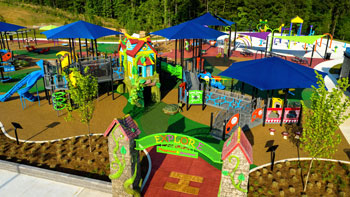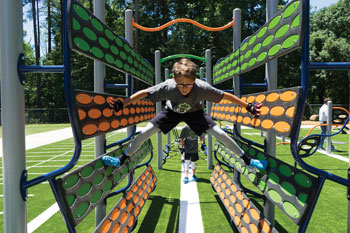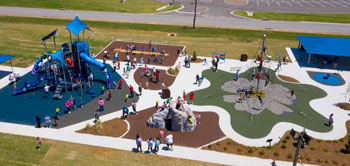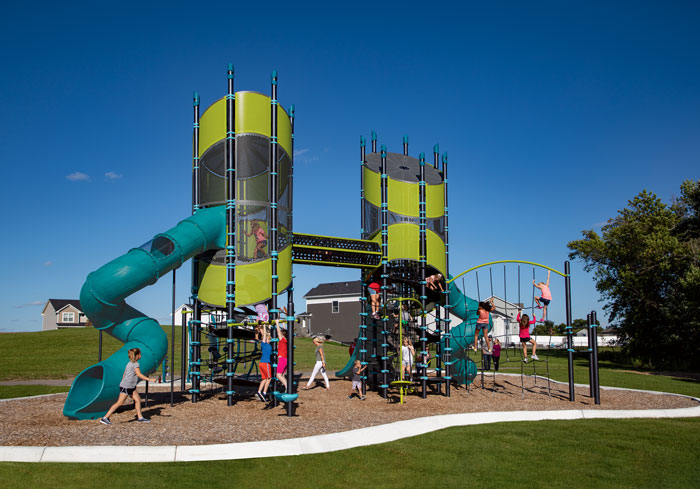Playground Trends, From Towers & Ropes to Nature, Inclusion & More
I think it’s safe to say that most of us occasionally daydream about being a kid again. But it’s not always about recapturing some lost innocence or getting a do-over—sometimes it’s simply because we want to play! And sometimes when you see the impressive play structures on a modern playground, the urge to climb, swing, slide and spin is overwhelming. And while kids simply want to partake in these activities because it’s fun, the designers of these structures and spaces realize that play is more than fun, it’s a crucial part of a kid’s growth, providing physical, cognitive, sensory and social benefits. Therefore, they’re always gathering information to inform what these play spaces should look and feel like.
“Information will be the critical element in new parks and recreation spaces,” said Kent Callison, marketing director of a Fort Payne, Ala.-based company that designs and manufactures playground equipment. Callison pointed out that the Forbes Technology Council called data “the currency of the next decade,” and explained that park managers and communities are looking for data to help determine where parks should be built, what amenities should be included and how these efforts impact families’ lives. “Data points such as the number of visits to a park, the ages of visitors, the length of stay, distance traveled, the amount of physical activity, etc., are key to understanding the role parks play in communities.” Callison added that funders also want to know how their contributions to park projects are delivering outcomes that they can share with the community and with other stakeholders.

Of course, when it comes to playgrounds, kids only care about those amenities mentioned above, so let’s look at some of the fun stuff. Playground towers are increasingly impressive, and Callison’s firm offers fully enclosed structures with platforms up to 12 feet tall and roof heights up to 22 feet. There are preconfigured structures, or custom towers can be designed featuring various climbers, slides, roof systems, interactive components and more. Specific styles and themes can be achieved, including rocket ships, skyscrapers, castles or redwood trees.
“Tower play systems create fun and exciting elevated play areas that encourage positive risk-taking and give children a new perspective of the world around them,” said Callison. Designs that save space are often requested, he added, and they’ve developed a series of towers using square platforms to save space and reduce cost. Options for customization are another big request, to “give customers a lot of flexibility in design to create a tower that is as unique as their community.”
Net- and rope-based play systems are also popular, and according to Callison, this is because they give children a different type of climbing challenge from a traditional ladder. “The rope or cable moves as a child climbs, and this enhances both physical and cognitive development. They’re also a lot of fun!”
He said communities have asked for two things when it comes to net climbers: challenging play experiences for children of all ages, and inclusive net experiences for children of all abilities. His company’s inclusive net climber features a transfer platform at one end, making it possible for users to transfer to or from a mobility device. It attaches to an accessible path with a six-foot slide at the other end, adding a play experience that benefits everyone.
In fact, there’s been a lot of education and advocacy surrounding the need for inclusive play since the passage of the Americans with Disabilities Act 30 years ago, according to Callison, who said that inclusive playground designs are now more essential than ever. He cited Department of Education numbers stating that approximately 6 million children in America between the ages of 3 and 21 had a disability in 2015, and in 2022 that number is 8 million, an increase of 33%. “As the population increases, so does the need.”
Callison also said that intergenerational play is on the minds of many parks directors, with 60 million American homes housing three generations of family members, and 80% of park users being over the age of 50 and under the age of 12. “While it may seem prudent to create separate recreation experiences for these two seemingly divergent population groups, the opposite approach has a profound effect on children and older adults.” Callison said there are significant social, physical, emotional and cognitive benefits when parents or grandparents play together with children.
Obstacle courses are one popular form of intergenerational play, with preconfigured courses or design-your-own versions available, according to Callison. His company offers a youth version for those ages 5 to 12 and a “pro” series accommodating users 13 and older. Many of the course components can be incorporated as freestanding play events on a playground. “One of the most requested items from customers was a way to incorporate more obstacle course-style activity in play areas.”
Callison said the youth version has been a huge hit with elementary schools, and middle and high schools have been adding the pro series. “It’s a great way to get older children engaged in physical activity, and in some cases teams use the course for additional athletic training. In parks, we see both ranges installed.”
Many schools are upping their game with regard to playgrounds, and Callison said that this can lead to improved academic success for students. He mentioned the six essential elements of play, according to the nonprofit membership organization SHAPE America: spinning, sliding, swinging, balancing, climbing, and brachiating (overhead climbing). “When you incorporate all six of these into a playground design, you can transform a playground into an extension of a PE class and allow students to be more active while they have fun.”
Callison cited studies showing that students who partake in physical activity during the school day have an increased chance of achieving better grades and higher test scores. “And if you incorporate fun, active lessons during recess just once per week, you increase students’ physical activity by 13% and decrease teachers’ time managing behavior by 21%.”
Dave Sheedy is vice president of sales for a playground equipment manufacturer based in Lewisburg, Pa. In May 2021, firefighters from Lewisburg and 12 other departments extinguished a fire at their campus, ensuring the safety of employees and the productivity of their factory. In June 2022, the Hufnagle Park Kidsburg Playground opened in Lewisburg as part of the Bull Run Greenway Improvement Project. Sheedy’s firm donated the playground equipment to honor first responders and the spirit of volunteerism, and he said they’ve been thrilled with the response. “It’s a popular destination for families in central Pennsylvania and, we think, a worthy tribute to our community’s first responders.”

The playground features many innovative play elements, including a geometric-shaped freestanding net climber, which Sheedy calls “towering and distinctive,” great for kids at “all levels of adventurousness.” “The (climber) is (more than) 15 feet high, allowing kids to climb, balance and teeter their way in, over and through to the colorful core. (It) includes an easy passage to the center, as well as a cozy space underneath.”
Sheedy agreed that net and rope play are gaining in popularity, and said “we anticipate this trend will continue for several years.”
A large single-piece slide is a new offering that Sheedy anticipates being very popular. “It’s a massive eight-foot, extra-wide slide, allowing for several children to enjoy sliding together.” And there are playhouses from the early childhood line (2- to 5-year-olds). “The first few years of a child’s life are the most crucial periods for learning, so we pack our early childhood products with academic, creative, physical, cognitive and social goodness. The playhouses help spur imaginative play; children can pretend to cook, clean and tend to the garden. It’s the details that make this playhouse super fun.”
There’s also a multigenerational face-to-face swing and an accessible swing seat. “Inclusive play equipment helps create an accessible world for children of all abilities. The Kidsburg Playground was designed to enable and inspire children with diverse abilities to play, and play is essential for all kids to grow and develop,” said Sheedy.
Support features at Kidsburg include solar lighting, which shines light in a downward trajectory from atop the equipment, helping to illuminate the playground without illuminating the surrounding area, according to Sheedy. He said the system is crafted to work seamlessly with most playgrounds, as its stair-step design can be secured to three different-sized posts. “Its cylindrical base allows for easy integration, simply taking the place of the dome-shaped caps that would otherwise be atop the posts.”
The playground also features 8,500 square feet of poured-in-place rubber safety surfacing, and shade is provided over various play features.
Sheedy said that while not always feasible, engaging key audiences before building a playground is a great way to ensure the space meets the needs of the community. “There is no one-size-fits-all answer to playground development. Rising health concerns across the country mean families in general are more interested in creating a supportive, engaging environment for children to get active.”
And what about current trends? “We’re seeing equipment that while still safe, is more daring and distinctive, including rope and sculpture play. Playgrounds that really work hard to bring the entire community together continue gaining in popularity,” which includes making the space as accessible and inclusive as possible.
Another play destination getting attention is the adventure playground, an area set aside where children partake in unrestricted play according to their own creative vision. “Adventure playgrounds can fill a huge gap for neighborhoods that lack enough space for children to play, or that have inadequate play offerings. A lot of NYC playgrounds mostly cater to toddlers’ interest in gross motor skills, for example,” said Zoe Fortin, executive director of play:groundNYC, a nonprofit organization “dedicated to transforming the city through play.” “Adventure playgrounds put kids in charge of their decisions, time and materials—a feeling that can be rare in a child’s life.”
The Yard—operated by play:groundNYC—is currently New York City’s only adventure playground. Young people are supplied with “loose parts” materials, including nails, hammers, saws, paint, tires, wood, fabrics and more. There are playworkers present at all times, supporting play through active engagement and awareness. They assess the benefits and risks involved in the play on physical, social and emotional levels, but don’t interrupt, offer unsolicited suggestions or break the flow of play. “All our playworkers follow a rigorous training and are paid,” said Fortin.
The Yard is open on weekends from April to November, and there are summer camps and the popular afterschool Adventure Play Club. “Kids leave school with our playworker, who escorts them to the ferry. They’re at The Yard all afternoon, before going back home, dirty and happy. A game changer for some city kids who don’t have a backyard or garage!”
There’s a family area for kids younger than 5, and the main area for those ages 5 to 19. The space is free and maintained through donations. “Some favorite features at The Yard include a mud pit with access to shovels and hose; the ability to build, decorate and destroy forts; some kids-made swings; a giant ‘hamster wheel’; costumes and arts and crafts materials, etc.”
And what about the possibility of combining aspects of traditional playgrounds with adventure playgrounds? “I’d love to see every playground staffed with a playworker,” said Fortin. “How fantastic would it be for community bonds? And I am encouraged by some traditional playground communities that have organized to integrate loose parts play, by leaving scooters and balls behind for all to enjoy, for example, or by welcoming cardboard boxes to create recyclable forts.”

The Irvine Adventure Playground at University Park in Irvine, Calif., has existed in some form since the 1970s, and it does feature a play structure with a tunnel slide and various climbers. “Adventure Playground encourages exploration and has many unique amenities, including a treehouse, climbing poles and stumps, slides, an art wall, kid’s fort zone, meadows and natural play areas,” said Pamela Baird, director of community services for the city of Irvine. There are also loose parts, “such as oversized Tonka trucks, sit-on sand diggers, giant connect four, bean bag toss, large building blocks, ping pong, foosball and we even bring out arts and crafts projects. We’re continuously looking into adding fun and new items that are a fit for the area.”
The fenced-in playground is a free drop-in facility open daily. “We schedule one staff member every day during operating hours,” said Baird. “The staff’s primary responsibility is to supervise the park and ensure cleanliness and safety. However, they will participate with children if attendance is low or if we’re providing a craft/activity.”
Inclusivity is also a consideration, and Baird explained that when designing the park, they were conscious of making wide pathways to ensure the site is accessible by all. “The sensory garden is what we call a butterfly garden. Flowers that are meant to attract butterflies were planted by local middle school volunteers. The space was designed for participants to enjoy a quiet, aesthetically pleasing sitting area.”
Other agencies from California and out of state have inquired about the site, according to Baird. “Some of them already have adventure playgrounds in their city or are looking to create one. Calls are typically made to see what our most popular features are, entrance fee and pre-registration (not required)”.
Site amenities at a playground shouldn’t be overlooked, to provide comfort and cleanliness to parents and caregivers as well as to kids. Things like benches, picnic tables, trash and recycling containers, drinking fountains and bike racks can go a long way toward attracting visitors and keeping them around longer. “Shade is one of the most requested site amenities,” said Callison, as it keeps play areas more comfortable and also blocks up to 97% of harmful UV rays, providing protection for people and equipment. “And there are so many fun options for shade structures in terms of style and color. You can completely change the look of a space with the right shade structures.”
Trail and nature-based play is another area that Callison is excited about. “Trail-based play and activity is a growing trend across America. It helps people of all ages experience the outdoors in a fun and innovative way. When you bring playful pathways to your community, you connect families to one another and with nature.”
But he pointed out that while there are more than 64,000 trails in the U.S., according to the All Trails website, studies suggest that only a small minority of children and families are actually using them. “There’s a growing movement to activate underutilized trails by infusing playful activities for people of all ages and abilities.”
This mindset helped lead to the development of the Play Trails concept, based on research found in the Pathways for Play guidebook, compiled by Callison’s firm’s parent company and the Natural Learning Initiative, College of Design, North Carolina State University. The guidebook contains research and design best practices for creating pockets of play along a trail. “One type of Play Trail uses manufactured playground equipment. The equipment is nature-themed and represents animals and their habitats. When children explore the trail, they discover fun play activities that teach them about the natural world.”
In fact, Callison recently gave a presentation to the National Association of State Park Directors about upcoming trends. Why might they be interested in playgrounds? “We’re seeing state park directors plan statewide upgrades to playgrounds, walking trails and other sports and outdoor spaces. Because they manage resources on a state level, their needs are different than the local parks departments, but they share a common goal: to create places that get everyone outdoors to play and be more active.” RM



